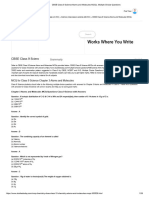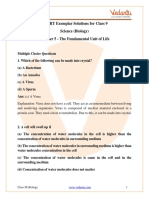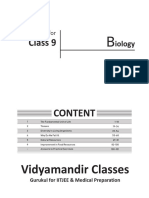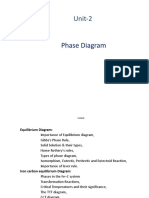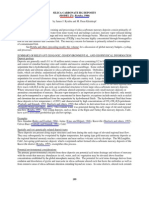CBSE NCERT Solutions For Class 9 Science Chapter 3: Back of Chapter Questions
CBSE NCERT Solutions For Class 9 Science Chapter 3: Back of Chapter Questions
Uploaded by
Narayanamurthy AmirapuCopyright:
Available Formats
CBSE NCERT Solutions For Class 9 Science Chapter 3: Back of Chapter Questions
CBSE NCERT Solutions For Class 9 Science Chapter 3: Back of Chapter Questions
Uploaded by
Narayanamurthy AmirapuOriginal Title
Copyright
Available Formats
Share this document
Did you find this document useful?
Is this content inappropriate?
Copyright:
Available Formats
CBSE NCERT Solutions For Class 9 Science Chapter 3: Back of Chapter Questions
CBSE NCERT Solutions For Class 9 Science Chapter 3: Back of Chapter Questions
Uploaded by
Narayanamurthy AmirapuCopyright:
Available Formats
Class- IX-CBSE-Science Atoms and Molecules
CBSE NCERT Solutions for Class 9 Science Chapter 3
Back of Chapter Questions
1. In a reaction, 5.3 g of sodium carbonate is reacted with 6 g of ethanoic acid. The
products were 2.2 g of carbon dioxide, 0.9 g water and 8.2 g of sodium ethanoate.
Show that these observations are in agreement with the law of conservation of mass.
Sodium carbonate+ethanoic acid → sodium ethanoate+carbon dioxide+water
Solution:
Here, for the given reaction,
Reactants: Mass of Sodium Carbonate (Na2 CO3 ) = 5.3 g and mass of Ethanoic
Acid (CH3 COOH) = 6 g
Products: Mass of Sodium ethanoate (CH3 COONa) = 8.2 g, mass of Carbon
dioxide (CO2 ) = 2.2 g and mass of Water (H2 O) = 0.9 g
Therefore,
Total mass of the given reactants = 5.3 g + 6 g = 11.3 g
Total mass of the given products = 2.2 g + 0.9 g + 8.2 g = 11.3 g
Thus, Total mass of reactants=total mass of products
Thus, the observations are in agreement with the law of conservation of mass.
2. Hydrogen and oxygen combine in the ratio of 1: 8 by mass to form water. What
mass of oxygen gas would be required to react completely with 3 g of hydrogen
gas?
Solution:
Using the law of constant proportions which states that in a chemical compound,
the elements are always present in definite proportions by mass.
Hydrogen and oxygen combine in the ratio of 1: 8 by mass to form water (Given).
1 g of hydrogen requires 8 grams of oxygen to form water.
Thus, in order to form water, 3 gram of hydrogen requires 3 × 8 = 24 g.
3. Which postulate of Dalton's atomic theory is the result of the law of conservation
of mass?
Solution:
The second postulate of Dalton's atomic theory is the result of the law of
conservation of mass.
Practice more on Atoms and Molecules Page - 1 www.embibe.com
Class- IX-CBSE-Science Atoms and Molecules
Second postulate of Dalton’s atomic theory is as follows:
"Atoms are indivisible particles, which cannot be created or destroyed in a chemical
reaction".
4. Which postulate of Dalton's atomic theory can explain the law of definite
proportions?
Solution:
The last postulate of Dalton's atomic theory which states that, "In a given
compound, the relative number and types of atoms are constant." explains the law
of definite proportion.
5. Define the atomic mass unit.
Solution:
Atomic mass unit is a mass unit equal to exactly one-twelfth the mass of a
carbon−12 atom. It is used to measure the masses of subatomic particles. It is
denoted as “amu”.
6. Why is it not possible to see an atom with naked eyes?
Solution:
The dimensions of atoms are extremely small, of the order of 1 nm. Hence, we
cannot see an atom with naked eyes.
7. Write down the formulae of
(i) sodium oxide
(ii) aluminium chloride
(iii) sodium sulphide
(iv) magnesium hydroxide
Solution:
(i) Formula of sodium oxide (made of sodium Na and oxygen O):
Thus, the formula of sodium oxide is Na2 O.
(ii) Formula of aluminium chloride (made of aluminium Al and chlorine Cl):
Practice more on Atoms and Molecules Page - 2 www.embibe.com
Class- IX-CBSE-Science Atoms and Molecules
Thus, the formula of aluminium chlorine is AlCl3 .
(iii) Formula of sodium sulphide (made of sodium Na and Sulphur S):
Thus, the formula of sodium sulphide is Na2 S.
(iv) Formula of magnesium hydroxide (made of magnesium Mg and hydroxide
OH):
Thus, the formula of magnesium hydroxide is Mg(OH)2 .
8. Write down the names of compounds represented by the following formulae:
(i) Al2 (SO4 )3
(ii) CaCl2
(iii) K 2 SO4
(iv) KNO3
(v) CaCO3
Solution:
Practice more on Atoms and Molecules Page - 3 www.embibe.com
Class- IX-CBSE-Science Atoms and Molecules
(i) Aluminium sulphate
(ii) Calcium chloride
(iii) Potassium sulphate
(iv) Potassium nitrate
(v) Calcium carbonate
9. What is meant by the term chemical formula?
Solution:
The chemical formula of a compound is a symbolic representation of its
composition.
For e.g.: K 2 SO4 is a chemical formula for Potassium sulphate.
10. How many atoms are present in a
(i) H2 S molecule and
(ii) PO3−
4 ion?
Solution:
(i) 3 (Two hydrogen atoms and one sulphur atom)
(ii) 5 (One phosphorus atom and four oxygen atoms)
11. Calculate the molecular masses of H2 , O2 , Cl2 , CO2 , CH4 , C2 H6 , C2 H4 , NH3 , CH3 OH.
(Given atomic mass H = 1u, O = 16 u, Cl = 35.5 u, C = 12 u, N = 14 u)
Solution:
Molecular mass of H2 = Mass of 2 hydrogen atoms = 1 u + 1 u = 2 u
Molecular mass of O2 = Mass of 2 oxygen atoms = 16 u + 16 u = 32 u
Molecular mass of Cl2 = Mass of 2 chlorine atoms = 35.5 u + 35.5 u = 71 u
Molecular mass of CO2 =Mass of 1 carbon atom + Mass of 2 oxygen atoms =
12 u + (2 × 16 u) = 44 u
Molecular mass of CH4 =Mass of 1 carbon atom + Mass of 4 hydrogen atoms=
12 u + (4 × 1 u) = 16 u
Molecular mass of NH3 =Mass of 1 nitrogen atom + Mass of 3 hydrogen atoms
= 14 u + (3 × 1 u) = 17u
Molecular mass of CH3 OH = Mass of 1 carbon atom + Mass of 3 hydrogen atoms
+ Mass of 1 oxygen atom + Mass of 1 hydrogen atom = 12 u + (3 × 1 u) +
16 u + 1 u = 32 u
Practice more on Atoms and Molecules Page - 4 www.embibe.com
Class- IX-CBSE-Science Atoms and Molecules
12. Calculate the formula unit masses of ZnO, Na2 O, K 2 CO3 , given atomic masses of
Zn = 65 u, Na = 23 u, K = 39u, C = 12 u, and O = 16 u.
Solution:
Formula unit mass of ZnO = 65 u + 16 u = 81 u
Formula unit mass of Na2 O = (2 × 23 u) + 16 u = 62 u
Formula unit mass of K 2 CO3 = (2 × 39 u) + 12 u + (3 × 16 u) = 138 u
13. If one mole of carbon atoms weighs 12 gram, then what is the mass (in grams) of
1 atom of carbon?
Solution:
1 mole = 6.022 × 1023 atoms
One mole of carbon atoms = 12 grams of carbon
Therefore, 6.022 × 1023 atoms of carbon=12 grams of carbon
Therefore,
12
1 atom of carbon = (6.022×1023 ) = 1.993 × 10−23 gram.
14. Which has more number of atoms, 100 grams of sodium or 100 grams of iron
(Given, atomic mass of Na = 23 u, Fe = 56 u)?
Solution:
23 g of sodium have one mole of atoms
1
Therefore, 100 g of sodium will have 23 × 100 = 4.35 moles
56 g of iron have one mole of atoms.
1
Therefore, 100 g of iron will have 56 × 100 = 1.78 moles
1 mole = 6.022 × 1023 atoms
Therefore, 100 g of sodium contains more atoms than 100 g of iron.
Back of the text
1. A 0.24 g sample of compound of oxygen and boron was found by analysis to
contain 0.096 g of boron and 0.144 g of oxygen. Calculate the percentage
composition of the compound by weight.
Solution:
Total mass of compound = 0.24 gram
Practice more on Atoms and Molecules Page - 5 www.embibe.com
Class- IX-CBSE-Science Atoms and Molecules
mass of boron in the compound = 0.096 gram
mass of oxygen in the compound = 0.144 gram
0.096
% of boron in the sample = 0.24
× 100 = 40%
0.144
% of oxygen in the sample = 0.24
× 100 = 60%
The sample of compound contains 40% boron and 60% oxygen by weight
2 When 3.0 g of carbon is burnt in 8.00 g oxygen, 11.00 g of carbon dioxide is
produced. What mass of carbon dioxide will be formed when 3.00 g of carbon is
burnt in 50.00 g of oxygen?
Which law of chemical combination will govern your answer?
Solution:
Here it is given that 3.0 g of carbon combines with 8.0 g of oxygen to give 11.0 of
carbon dioxide.
When 3.00 g of carbon is burnt in 50.00 g of oxygen, by “Law of constant
proportion”, only 8.00 g of oxygen will react to produce 11.00 gram of carbon
dioxide.
Rest 42.00 g of oxygen will remain unreacted.
Law of constant proportion governs the answer.
3. What are polyatomic ions? Give examples.
Solution:
A polyatomic ion is a charged chemical species (ion) composed of two or more
atoms that can be considered to be acting as a single unit. Some examples of
polyatomic ions are NO− + − 2− 2−
3 , NH4 , OH , SO4 , and SO3 .
4. Write the chemical formulae of the following:
(a) Magnesium chloride
(b) Calcium oxide
(c) Copper nitrate
(d) Aluminium chloride
(e) Calcium carbonate.
Solution:
(a) MgCl2
(b) CaO
Practice more on Atoms and Molecules Page - 6 www.embibe.com
Class- IX-CBSE-Science Atoms and Molecules
(c) Cu(NO3 )2
(d) AlCl3
(e) CaCO3
5. Give the names of the elements present in the following compounds.
(a) Quick lime
(b) Hydrogen bromide
(c) Baking powder
(d) Potassium sulphate.
Solution:
(a) (Calcium Oxide - CaO) Calcium and oxygen.
(b) (HBr) Hydrogen and Bromine.
(c) (NaHCO3 ) Sodium, hydrogen, carbon, and oxygen.
(d) (K 2 SO4 ) Potassium, sulphur, and oxygen.
6. Calculate the molar mass of the following substances.
(a) Ethyne, C2 H2
(b) Sulphur molecule, S8 (Atomic mass of Sulphur = 32 u)
(c) Phosphorus molecule, P4 (Atomic mass of Phosphorus = 31 u)
(d) Hydrochloric acid, HCl
(e) Nitric acid, HNO3
Solution:
(a) Molar mass of ethyne, C2 H2 = 2 × Mass of Carbon + 2 × Mass of
Hydrogen = 2 × 12 u + 2 × u = 26 u
(b) Molar mass of Sulphur molecule, S8 = 8 × Mass of Sulphur = 8 × 32 u =
256 u
(c) Molecular mass of phosphorus molecule, P4 = 4 × Mass of Phosphorus =
4 × 31 u = 124 u
(d) Molecular mass of HCl = Mass of Hydrogen + Mass of Chlorine = 1 u +
35.5 u = 36.5 u
(e) Molecular mass of HNO3 = Mass of Hydrogen + Mass of Nitrogen + 3 ×
Mass of Oxygen = 1 u + 14 u + 3 × 16 u = 63 u
7. What is the mass of
Practice more on Atoms and Molecules Page - 7 www.embibe.com
Class- IX-CBSE-Science Atoms and Molecules
(a) 1 mole of nitrogen atoms?
(b) 4 moles of aluminium atoms (Atomic mass of aluminium = 27)?
(c) 10 moles of sodium sulphite (Na2 SO3 )?
Solution:
(a) Mass of 1 mole of nitrogen atoms = atomic mass of nitrogen = 14 g
(b) Mass of 4 moles of aluminium atoms = 4 × Mass of 1 mole of Al atoms
molecular mass of aluminum = 4 × 27 = 108 g
(c) Mass of 10 moles of sodium sulphite = 10 × Mass of 1 mole of Na2 SO3 =
10 × molecular mass of Na2 SO3 .
Molecular mass of sodium sulphite, Na2 SO3 = 2(23) + 32 + 3(16) =
126 g
Thus, the mass of 10 moles of sodium sulphite = 10 × 126 = 1260 g
8. Convert into mole.
(a) 12 g of oxygen gas
(b) 20 g of water
(c) 22 g of carbon dioxide.
Solution:
(a) Molecular mass of oxygen in grams = 32 g
32 g of oxygen=one mole of oxygen gas
1
Thus, 12 g of oxygen = 32 × 12 = 0.375 moles
(b) Molecular mass of water (H2 O) in grams = 2 + 16 = 18 g = one mole of
water
18 g of water = one mole of water.
1
Thus, 20 g of water = 18 × 20 = 1.11 moles of water
(c) Molecular mass of carbon dioxide (CO2 ) in grams = 12 + 2 × 16 = 44 g
44 g of carbon dioxide=one mole of carbon dioxide
Thus,
1
22 g of carbon dioxide = 44 × 22 = 0.5 moles
9. What is the mass of:
(a) 0.2 mole of oxygen atoms?
Practice more on Atoms and Molecules Page - 8 www.embibe.com
Class- IX-CBSE-Science Atoms and Molecules
(b) 0.5 mole of water molecules?
Solution:
(a) Mass of 1 mole of oxygen atoms = 16 g
Mass of 0.2 moles of oxygen atoms = 0.2 × 16 g = 3.2 g
(b) Mass of 1 mole of water molecules = 18 g
Mass of 0.5 mole of water molecules = 0.5 × 18 = 9 g
10. Calculate the number of molecules of Sulphur (S8 ) present in 16 g of solid sulphur
Solution:
Molecular mass of Sulphur molecule = 256 g
256 g of Sulphur contains one mole of Sulphur molecules
1
Thus, 16 g of Sulphur will contain = 256 × 16 = 0.0625 moles of Sulphur
molecules
1 mole of Sulphur molecules = 6.022 × 1023 molecules
Therefore, 0.0625 mole of Sulphur molecule = 6.022 × 1023 × 0.0625
= 3.76375 × 1022 sulphur molecules
i.e., number of molecules of Sulphur present in 16 g of solid Sulphur is
3.76375 × 1022
11. Calculate the number of aluminium ions present in 0.051 g of aluminium oxide.
(Hint: The mass of an ion is the same as that of an atom of the same element.
Atomic mass of Al = 27 u)
Solution:
1 mole of aluminium oxide = 2 × 27 + 3 × 16 = 102 grams
102 grams aluminium oxide has = 6.023 × 1023 aluminium oxide molecules
6.023×1023 ×0.051
0.051 gram of aluminium oxide has = 102
= 3.01 × 1020 aluminium oxide molecules
1 molecule of aluminium oxide gives = 2Al+ ions
Hence 0.051 grams aluminium oxide gives = 2 × 3.01 × 1020 Al+ ions.
= 6.023 × 1020 aluminium ions
Practice more on Atoms and Molecules Page - 9 www.embibe.com
You might also like
- Adidas V Thom BrowneDocument27 pagesAdidas V Thom BrowneMaksimNo ratings yet
- Deus Manual Uk v5 2018Document52 pagesDeus Manual Uk v5 2018JJ GDel100% (1)
- MCQ - Class 9 - Atoms and MoleculesDocument28 pagesMCQ - Class 9 - Atoms and Moleculesget2maniNo ratings yet
- NCERT Exemplar For Class 9 Science Chapter 6Document30 pagesNCERT Exemplar For Class 9 Science Chapter 6Vidhan PanwarNo ratings yet
- Class 9 Physics Chapter 9 Force and Law of Motion MCQsDocument2 pagesClass 9 Physics Chapter 9 Force and Law of Motion MCQsMujtahid LatiefNo ratings yet
- Important Questions For CBSE Class 9 Science Chapter 5Document5 pagesImportant Questions For CBSE Class 9 Science Chapter 5Mr CrownNo ratings yet
- Class 9 Science Chapter 15 Revision Notes BESTUM..Document5 pagesClass 9 Science Chapter 15 Revision Notes BESTUM..Rohinish DeyNo ratings yet
- CBSE Class 9 - Ch9 - Force and Laws of MotionDocument21 pagesCBSE Class 9 - Ch9 - Force and Laws of Motionscribd_homeNo ratings yet
- NEET Test Series 01 - NEET Test-01Document3 pagesNEET Test Series 01 - NEET Test-01aditi.sengar2022No ratings yet
- NEET Test Series 11Document24 pagesNEET Test Series 11bal_thakreNo ratings yet
- Class 11 Biology Chapter 7 - Revision NotesDocument32 pagesClass 11 Biology Chapter 7 - Revision Notesshusa harsha100% (1)
- NCERT Solutions For Class 9 Science Chapter 6 - Tissues - .Document9 pagesNCERT Solutions For Class 9 Science Chapter 6 - Tissues - .AshchatNo ratings yet
- MCQ Chemistry PDFDocument19 pagesMCQ Chemistry PDFV Srinivasa RaoNo ratings yet
- Force and Laws of Motion NotesDocument6 pagesForce and Laws of Motion NotesVedeshNo ratings yet
- Chapter 06 TissuesDocument20 pagesChapter 06 TissuesManushi Shah100% (1)
- CBSE Sample Paper Class 9 Science Set 7Document4 pagesCBSE Sample Paper Class 9 Science Set 7Pradeep Kumar BajpaiNo ratings yet
- IX Biology (Improvement in Food Resources) WS-3Document3 pagesIX Biology (Improvement in Food Resources) WS-3physicsbooks.storeNo ratings yet
- CBSE Class 9 Science Matter in Our SurroundingsDocument8 pagesCBSE Class 9 Science Matter in Our SurroundingsDhananjay karadNo ratings yet
- Science Class7 PhysicalnChemicalChange RevisionNotes PDFDocument5 pagesScience Class7 PhysicalnChemicalChange RevisionNotes PDFTestEmailForScribd TestEmailForScribdNo ratings yet
- NCERT Questions - Improvement in Food Resources - Everonn - CBSE Class-9thDocument6 pagesNCERT Questions - Improvement in Food Resources - Everonn - CBSE Class-9thViren PatelNo ratings yet
- NCERT Exemplar Solution Class 9 Chapter 5Document18 pagesNCERT Exemplar Solution Class 9 Chapter 5Pratham GuptaNo ratings yet
- Class 9 NCERT Solutions Natural Resources-CroppedDocument10 pagesClass 9 NCERT Solutions Natural Resources-CroppedAnupam SahariahNo ratings yet
- Is Matter Around Us Pure (26-64)Document38 pagesIs Matter Around Us Pure (26-64)Anirudha SharmaNo ratings yet
- CHY1009 Module 4 - Engineering MaterialsDocument45 pagesCHY1009 Module 4 - Engineering Materialsgopi chand mallela100% (1)
- Class 8th ScienceDocument238 pagesClass 8th ScienceSanchiNo ratings yet
- 9th Matter in Our SurroundingsDocument3 pages9th Matter in Our SurroundingsAmmär MasòódNo ratings yet
- MotionDocument7 pagesMotionAsfia QuadirNo ratings yet
- Important Questions For CBSE Class 7 Science Chapter 11Document7 pagesImportant Questions For CBSE Class 7 Science Chapter 11Atabuddin MondalNo ratings yet
- NCERT Exemplar For Class 9 Science Chapter 5Document27 pagesNCERT Exemplar For Class 9 Science Chapter 5Vidhan PanwarNo ratings yet
- Notes-Cell The Unit of Life NewDocument18 pagesNotes-Cell The Unit of Life NewKisna guptaNo ratings yet
- Exercise-6.1: NCERT Solution For Class 9 Science - Chapter 6 TissuesDocument9 pagesExercise-6.1: NCERT Solution For Class 9 Science - Chapter 6 TissuesShah RukhNo ratings yet
- Assignment Colour Compound (Mega) 215Document2 pagesAssignment Colour Compound (Mega) 215Anant JainNo ratings yet
- PCA Rules CommentaryDocument171 pagesPCA Rules Commentarybeejal ahujaNo ratings yet
- Electricity: Electric CurrentDocument10 pagesElectricity: Electric CurrentTajiriMollelNo ratings yet
- Tissue Class-11 (Notes)Document18 pagesTissue Class-11 (Notes)Harsh RanjanNo ratings yet
- Cell - The Fundamental Unit of Life LESSONDocument104 pagesCell - The Fundamental Unit of Life LESSONGrade 4 B TeacherNo ratings yet
- Identification of Fibers ThroughDocument1 pageIdentification of Fibers ThroughDhana SeelanNo ratings yet
- Topper 8 110 2 2 Chemistry 2008 Questions Up201506182058 1434641282 7298Document7 pagesTopper 8 110 2 2 Chemistry 2008 Questions Up201506182058 1434641282 7298Manohar GarimellaNo ratings yet
- 8102class-5 ch-14 Transport and CommunicationDocument4 pages8102class-5 ch-14 Transport and CommunicationPeehu singhalNo ratings yet
- 6 TissuesDocument20 pages6 TissuesSarika NiranjaniNo ratings yet
- Class 8 - Science - Synthetic Fibres and PlasticsDocument5 pagesClass 8 - Science - Synthetic Fibres and PlasticsAyaan KhuranaNo ratings yet
- Chapter 1 - Matter in Our SurroundingDocument11 pagesChapter 1 - Matter in Our Surroundingcrapjorust123No ratings yet
- The Fundamental Unit of Life To Improvement in Food Resources ChaptersDocument104 pagesThe Fundamental Unit of Life To Improvement in Food Resources ChaptersSARANSH oPNo ratings yet
- CBSE Class 12 Biology 2019 Question Paper Solution Set 4Document14 pagesCBSE Class 12 Biology 2019 Question Paper Solution Set 4PavanNo ratings yet
- Buzzer Round QuestionsDocument2 pagesBuzzer Round QuestionsraviNo ratings yet
- Animal Kingdom Class 11 Notes Biology Chapter 4Document17 pagesAnimal Kingdom Class 11 Notes Biology Chapter 4dharun0704No ratings yet
- Life Processes NotesDocument7 pagesLife Processes NotesTalented ShivaanshNo ratings yet
- To Study The Variations of Pressure and Volume of Air.Document19 pagesTo Study The Variations of Pressure and Volume of Air.YUGANT SACHIN BHUTENo ratings yet
- SST PreboardDocument6 pagesSST PreboardRuby LathaNo ratings yet
- Science Class 9th Lesson 6 NOTESDocument3 pagesScience Class 9th Lesson 6 NOTESChaitanya Seriouskalhapure100% (1)
- MA/MSCMT-01 M.A./M.Sc. (Previous) Mathematics Examination Advanced Algebra Paper - MA/MSCMT-01Document4 pagesMA/MSCMT-01 M.A./M.Sc. (Previous) Mathematics Examination Advanced Algebra Paper - MA/MSCMT-01nikhil pandya100% (1)
- Class 11 Physics em 5 Marks GuidesDocument47 pagesClass 11 Physics em 5 Marks Guidesrichard andrewsNo ratings yet
- The Fundamental Unit of Life Class 9 Notes Chapter 5Document7 pagesThe Fundamental Unit of Life Class 9 Notes Chapter 5AdvayNo ratings yet
- Abuse of DominanceDocument9 pagesAbuse of DominanceAstha AgarwalNo ratings yet
- DIVE! English PORTRAIT V12020.09.30T141038+0000Document25 pagesDIVE! English PORTRAIT V12020.09.30T141038+0000Rose Ann DongonNo ratings yet
- Carbon and Its Compounds Ncert Notes For Class 10 Download PDFDocument4 pagesCarbon and Its Compounds Ncert Notes For Class 10 Download PDFgooodeNo ratings yet
- Class Viii Science Chap 3 Synth FibresDocument4 pagesClass Viii Science Chap 3 Synth FibresAbhaygyan SinghNo ratings yet
- MCQ - Class 9 - Physics - GravitationDocument15 pagesMCQ - Class 9 - Physics - Gravitationget2maniNo ratings yet
- English 9Document12 pagesEnglish 9Laxmi PanchNo ratings yet
- Board of Intermediate Education: Senior Inter Model Paper ChemistryDocument2 pagesBoard of Intermediate Education: Senior Inter Model Paper Chemistryrathod adithNo ratings yet
- Exercise - 3.1: NCERT Solutions For Class 9 Science Chapter 3 Atoms and MoleculesDocument12 pagesExercise - 3.1: NCERT Solutions For Class 9 Science Chapter 3 Atoms and MoleculesMannat MadanNo ratings yet
- Bonafide Certificate From School by ParentsDocument1 pageBonafide Certificate From School by ParentsNarayanamurthy Amirapu100% (1)
- CBSE Sample Paper Class 9 Maths Set 12Document4 pagesCBSE Sample Paper Class 9 Maths Set 12Narayanamurthy AmirapuNo ratings yet
- CBSE Sample Paper Class 9 Maths Set 13Document5 pagesCBSE Sample Paper Class 9 Maths Set 13Narayanamurthy AmirapuNo ratings yet
- AndarikiAyurvedam SamvatsaraSanchika 1Document260 pagesAndarikiAyurvedam SamvatsaraSanchika 1Narayanamurthy Amirapu100% (1)
- CBSE Class 9 Maths Sample Paper Set 11: General InstructionDocument4 pagesCBSE Class 9 Maths Sample Paper Set 11: General InstructionNarayanamurthy AmirapuNo ratings yet
- CBSE Sample Paper Class 9 Science Set 2 SolutionDocument7 pagesCBSE Sample Paper Class 9 Science Set 2 SolutionNarayanamurthy AmirapuNo ratings yet
- CBSE NCERT Solutions For Class 9 Science Chapter 2: Back of Chapter QuestionsDocument15 pagesCBSE NCERT Solutions For Class 9 Science Chapter 2: Back of Chapter QuestionsNarayanamurthy AmirapuNo ratings yet
- CBSE NCERT Solutions For Class 9 Science Chapter 8Document10 pagesCBSE NCERT Solutions For Class 9 Science Chapter 8Narayanamurthy AmirapuNo ratings yet
- ICSE Board Class IX Biology Paper - 2 Solution: Section-I Answer 1 (A)Document7 pagesICSE Board Class IX Biology Paper - 2 Solution: Section-I Answer 1 (A)Narayanamurthy AmirapuNo ratings yet
- CBSE NCERT Solutions For Class 9 Science Chapter 13: Back of Chapter QuestionsDocument6 pagesCBSE NCERT Solutions For Class 9 Science Chapter 13: Back of Chapter QuestionsNarayanamurthy AmirapuNo ratings yet
- CBSE NCERT Solutions For Class 9 Science Chapter 14: Back of Chapter QuestionsDocument6 pagesCBSE NCERT Solutions For Class 9 Science Chapter 14: Back of Chapter QuestionsNarayanamurthy AmirapuNo ratings yet
- Biology 9 Icse Sample Paper 6 SolutionDocument10 pagesBiology 9 Icse Sample Paper 6 SolutionNarayanamurthy AmirapuNo ratings yet
- Concise Selina Solutions For Class 9 Maths Chapter 2 Compound Interest Without Using FormulaDocument26 pagesConcise Selina Solutions For Class 9 Maths Chapter 2 Compound Interest Without Using FormulaNarayanamurthy AmirapuNo ratings yet
- Biology 9 Icse Sample Paper 1Document6 pagesBiology 9 Icse Sample Paper 1Narayanamurthy AmirapuNo ratings yet
- Biology 9 Icse Sample Paper 1 SolutionDocument8 pagesBiology 9 Icse Sample Paper 1 SolutionNarayanamurthy AmirapuNo ratings yet
- Concise Selina Solutions For Class 9 Maths Chapter 4 ExpansionsDocument47 pagesConcise Selina Solutions For Class 9 Maths Chapter 4 ExpansionsNarayanamurthy AmirapuNo ratings yet
- Concise Selina Solutions For Class 9 Maths Chapter 3 Compound Interest Using FormulaDocument42 pagesConcise Selina Solutions For Class 9 Maths Chapter 3 Compound Interest Using FormulaNarayanamurthy AmirapuNo ratings yet
- Concise Selina Solutions For Class 9 Maths Chapter 3 Compound Interest Using FormulaDocument42 pagesConcise Selina Solutions For Class 9 Maths Chapter 3 Compound Interest Using FormulaNarayanamurthy AmirapuNo ratings yet
- Gekjs Vkl&Ikl Osq Inkfkz: (Matter in Our Surroundings)Document14 pagesGekjs Vkl&Ikl Osq Inkfkz: (Matter in Our Surroundings)Narayanamurthy AmirapuNo ratings yet
- Thoksa Esa Fofo/rkDocument18 pagesThoksa Esa Fofo/rkNarayanamurthy AmirapuNo ratings yet
- Final Project of Rayeen SteelsDocument56 pagesFinal Project of Rayeen SteelsShiva PrasannaNo ratings yet
- Inorganic Chem 2 PRACTICAL 1Document10 pagesInorganic Chem 2 PRACTICAL 1Basil EbebeNo ratings yet
- Tec Spec - Boiler PDFDocument15 pagesTec Spec - Boiler PDFrama100% (1)
- Applications of Microorganisms To Geotechnical EngineeringDocument15 pagesApplications of Microorganisms To Geotechnical EngineeringAshokan KelothNo ratings yet
- Azipine PDFDocument58 pagesAzipine PDFGanesamoorthy Thirunarayanan67% (3)
- Pure Iron, Allotropy:: Steels Are Alloys of Iron and Carbon With Carbon Content Up To 2%Document13 pagesPure Iron, Allotropy:: Steels Are Alloys of Iron and Carbon With Carbon Content Up To 2%Abhishek SakatNo ratings yet
- Experiment: Elements, Compounds and Mixtures: Materials RequiredDocument3 pagesExperiment: Elements, Compounds and Mixtures: Materials RequiredYang SwanNo ratings yet
- Vol8No3&4 13 Development MineralBased Industries IzharHaqueDocument12 pagesVol8No3&4 13 Development MineralBased Industries IzharHaquenasir.hdip8468No ratings yet
- The Ciw Index: A New Chemical Index of Weathering : Sedimentary GeologyDocument4 pagesThe Ciw Index: A New Chemical Index of Weathering : Sedimentary GeologyLaode Jonas TugoNo ratings yet
- CorrosionDocument14 pagesCorrosionanon_72577581% (16)
- Microsoft Word - STOICHIOMETRY-ASSIGNMENT - 1 PDFDocument15 pagesMicrosoft Word - STOICHIOMETRY-ASSIGNMENT - 1 PDFggk201350% (4)
- DIN Grades SteelDocument7 pagesDIN Grades SteelJai BhandariNo ratings yet
- Development of CRGO Steel:-A Chronological Review: November 2013Document2 pagesDevelopment of CRGO Steel:-A Chronological Review: November 2013AshtosheelatikaNo ratings yet
- Oteluri InoxidabileDocument5 pagesOteluri InoxidabilemariuspiNo ratings yet
- Unit-2: Phase DiagramDocument37 pagesUnit-2: Phase DiagramPrasad Govind KumbharNo ratings yet
- The EURO Currency Coins: Research atDocument37 pagesThe EURO Currency Coins: Research atSherif EltoukhiNo ratings yet
- Curve Ansi Short Radius (R 1 D) Cod. RFW356Document1 pageCurve Ansi Short Radius (R 1 D) Cod. RFW356AHMED AMIRANo ratings yet
- Assessment of Foundry Properties of Steel Casting Sand Moulds Bonded With The Grade 4 Nigerian Acacia Species (Gum Arabic)Document4 pagesAssessment of Foundry Properties of Steel Casting Sand Moulds Bonded With The Grade 4 Nigerian Acacia Species (Gum Arabic)Ardani AsaNo ratings yet
- Jjmie: Strengthening Aluminum Scrap by Alloying With IronDocument5 pagesJjmie: Strengthening Aluminum Scrap by Alloying With IronAnonymous VNu3ODGavNo ratings yet
- Buderus G234X and G334X Gas Fired Hot Water Cast Iron Boiler BrochureDocument8 pagesBuderus G234X and G334X Gas Fired Hot Water Cast Iron Boiler Brochuree-ComfortUSANo ratings yet
- Jee Main 2023 April 8 Morning Shift Question Paper With SolutionsDocument25 pagesJee Main 2023 April 8 Morning Shift Question Paper With SolutionsPavithraBhishmaNo ratings yet
- Neet-Jee MetallurgyDocument14 pagesNeet-Jee MetallurgySudheerkhan MuhammedNo ratings yet
- TOTIME End Mill (2019-2020) ★定価のみ★最新20190501Document26 pagesTOTIME End Mill (2019-2020) ★定価のみ★最新20190501Anonymous ltmd7gPBNo ratings yet
- Machine Design ReviewerDocument4 pagesMachine Design ReviewerNathalie Gyle GalvezNo ratings yet
- Silica-Carbonate HG Deposits (MODEL 27c Rytuba, 1986)Document5 pagesSilica-Carbonate HG Deposits (MODEL 27c Rytuba, 1986)Resa Rifal PraditiaNo ratings yet
- Metals - Form 4 Chemistry Topical QuestionsDocument13 pagesMetals - Form 4 Chemistry Topical QuestionsEmmanuel KipyegonNo ratings yet
- Module POI-3-23.4.2024Document21 pagesModule POI-3-23.4.2024avanthikaasri mNo ratings yet
- Friction and Wear Data Bank: A. William RuffDocument39 pagesFriction and Wear Data Bank: A. William RuffGhania Nashwa FairuzaNo ratings yet
- Research Paper On IronDocument7 pagesResearch Paper On Ironafmctmvem100% (1)


